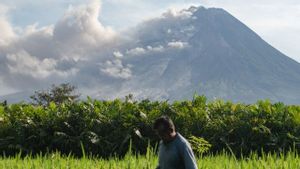YOGYAKARTA - The existence of 12 species of mammals in Mount Merapi National Park (TNGM) is threatened, due to natural disturbances in the area of an active volcano on the border of the Special Region of Yogyakarta and Central Java.
This refers to the research results of a student at the Doctoral Study Program in Forestry Sciences, Faculty of Forestry, Gadjah Mada University (UGM) Nurpana Sulaksono.
"Using dozens of camera traps, it is known that there are 12 species of mammals, 10 of which are land mammals. The most numerous are long-tailed monkeys, deer, porcupines, and mongooses," said Nurpana Sulaksono in an official statement from UGM received in Yogyakarta, confirmed by Antara, Tuesday, March 14th.
As many as 12 types of large to medium-sized mammals live in the TNGM area, including monkeys, deer, porcupines, mongoose, langurs, wild boars, pangolins, forest cats, langurs, boils, rase, and flying squirrels.
According to Nurpana, natural disturbances that threaten the existence of wild animals in the Merapi area are periodic eruptions.
In addition, disturbances from human activities in the form of grazing, mining, and tourism activities in the area.
In his dissertation entitled "Response of Medium-Large Land Mammals to Various Types of Disturbance in the Landscape of Mount Merapi National Park", he said that mammals of medium and large sizes, such as monkeys and langurs or antelope tend to avoid and stay away from areas close to disturbances, both settlements as well as mining.
"These animals tend to be in tightly closed areas and away from settlements and mining areas, and prefer land that is rather high," he said.
Related to the availability of habitat for mammal populations in TNGM, according to Nurpana, the forest cat has the most extensive habitat which occupies an area of 5,000 hectares, both inside and outside the TNGM.
Next, there are mongooses occupying an area of 4,700 hectares and deer in an area of 3,000 hectares, both outside and within the national park area.
However, he added, the condition of the deer's habitat is currently experiencing fragmentation due to eruptions and activities in residential areas.
The habitat locations are to the north and south of Mount Merapi.
"Between the northern and southern regions is disconnected which will have an impact on the preservation of areas whose populations should be able to connect," he said.
According to Nurpana, the highest disturbance occurred in habitats affected by mining activity disturbances.
Habitats with high levels of disturbance tend to respond with low species richness and low diversity of mammal species.
In undisturbed habitats, they tend to have high richness but have the lowest level of mammal diversity due to the dominance of certain animal species.
Dari hasil penelitian ini, Nurpana merekomendasikan untuk dilakukan pengukuran kondisi mamalia secara aktif dan berkelanjutan untuk mengetahui dinamika dan perkembangan jumlah populasi dan habitat.
In addition, it is necessary to set the time for the activity of collecting grass by the community.
"Arrangements are made to prevent disturbance from exceeding the tolerance threshold which can have direct and indirect impacts on wild animals, especially mammals," he said.
No less important, according to him, is securing the area to prevent poaching, and regulating and controlling rock and sand excavation activities to prevent habitat fragmentation.
SEE ALSO:
"Uncontrolled extraction of stone and sand materials can cause a loss of connectivity between habitats," he said.
The English, Chinese, Japanese, Arabic, and French versions are automatically generated by the AI. So there may still be inaccuracies in translating, please always see Indonesian as our main language. (system supported by DigitalSiber.id)












